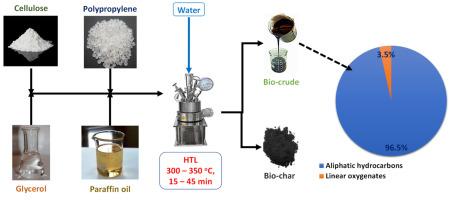使用共溶剂对纤维素和聚丙烯进行水热共液化反应
IF 8
Q1 ENERGY & FUELS
引用次数: 0
摘要
利用生物聚合物和合成聚合物产生的中间产物之间的协同作用,在亚临界状态下转化热稳定的烯烃塑料是一种很有前景的策略。本研究对纤维素和聚丙烯(PP)进行了共液化,并深入研究了温度(300-350 °C)、停留时间(15-45 分钟)、纤维素与聚丙烯的质量比(25:75、50:50 和 75:25 w%/w%)以及助溶剂(甘油、石蜡油)对产品产量和质量的影响。结果表明,仅用水不足以液化 PP,而加入甘油和石蜡油可大大提高转化率和生物原油产量。使用水:甘油溶剂,在 350 °C-30 分钟内,纤维素:聚丙烯的比例为 50:50 w%/w%,生物原油产量最高(78.6 wt.%)。在水-石蜡油溶剂中,纤维素与聚丙烯的比例为 25:75 w%/w%,在 350 °C-15 分钟时,生物原油中脂肪烃的选择性很高(96.5%)。本文章由计算机程序翻译,如有差异,请以英文原文为准。

Hydrothermal Co-liquefaction of Cellulose and Polypropylene using Co-solvents
Hydrothermal co-liquefaction of feedstocks that decompose in widely different temperature regimes is a promising strategy to convert thermally stable olefinic plastics at sub-critical conditions by utilizing the synergetic interactions between the intermediates generated from biopolymers and synthetic polymers. In this study, cellulose and polypropylene (PP) are co-liquefied, and the effects of temperature (300–350 °C), residence time (15–45 min), cellulose-to-PP mass ratio (25:75, 50:50 and 75:25 w%/w%) and co-solvents (glycerol, paraffin oil) on product yields and quality are thoroughly studied. Results suggest that water alone is inadequate to liquefy PP, while the incorporation of glycerol and paraffin oil greatly enhance the conversion and the bio-crude yield. Maximum bio-crude yield (78.6 wt.%) was obtained at 350 °C-30 min with cellulose:PP of 50:50 w%/w% using water:glycerol solvent. The selectivity to aliphatic hydrocarbons in the bio-crude was high (∼96.5 %) at 350 °C-15 min for a cellulose:PP ratio of 25:75 w%/w% in water-paraffin oil solvent.
求助全文
通过发布文献求助,成功后即可免费获取论文全文。
去求助
来源期刊

Energy nexus
Energy (General), Ecological Modelling, Renewable Energy, Sustainability and the Environment, Water Science and Technology, Agricultural and Biological Sciences (General)
CiteScore
7.70
自引率
0.00%
发文量
0
审稿时长
109 days
 求助内容:
求助内容: 应助结果提醒方式:
应助结果提醒方式:


